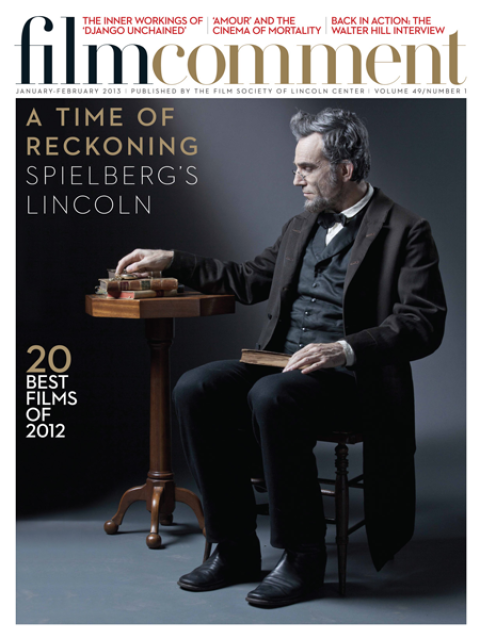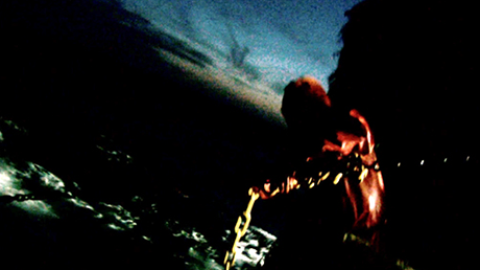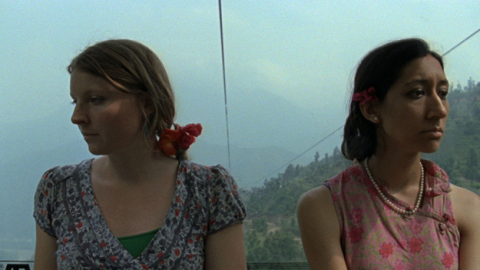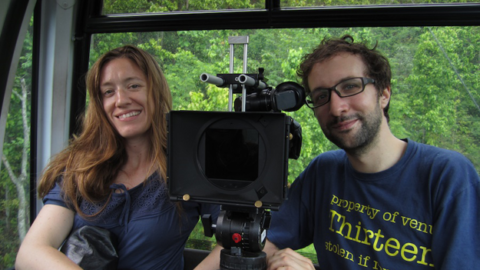
Alert the genre police: Leviathan is the best horror film of the year. In public remarks, co-directors Lucien Castaing-Taylor and Véréna Paravel have admitted, like proud Frankenstein parents, the difficulties they’ve had with classifying their creation. In an interview in The New York Times, Castaing-Taylor proclaimed: “It is utterly a documentary . . . But it also doesn’t feel like a documentary to me. It feels more like a horror film or science fiction.” Paravel backed him up: “We still don’t know exactly what the film is about.”
Leviathan follows a small crew of industrial fishermen on what is presumably a routine soul-crushing, fish-disemboweling night at sea. The particulars of the nautical position, the actual stretch of time, and even the workers’ identities play no significant role in this nonnarrative fever dream. In a bit of telling conflation, the end credits lump together the ship’s complement with the Latin names of the various marine creatures seen on screen: seaman Johnny Gatcombe, for example, can be found between Homarus americanus and Larus argentatus smithsonianus.
The filmmakers strategically positioned submersible, viscera-resistant GoPro cameras throughout the vessel: one was positioned aloft on a windswept mast; another was strapped to a pole that could be plunged into the swells or swung through the air to capture the flight of the omnipresent gulls; yet another, perhaps the most empathetic, was allowed to slide about the ship’s deck, making unnerving eye contact with freshly severed fish heads. But much of the film’s imagery (and sound) came from cameras attached to the fishermen themselves, providing fragmentary, disorienting POVs in constant motion. (That the lenses and their housings are bathed in an almost perpetual spray of seawater and fish guts only reinforces the film’s elemental ethos.) In documentary terms the viewer learns very little about what the workers actually do—and plenty about the conditions they must endure.

Castaing-Taylor directs Harvard’s Sensory Ethnography Lab (SEL), a multi-departmental collaborative effort that has played a role in such projects as the ingenious 2007 sheepherding doc, Sweetgrass, and the equally engaging 2011 chop-shop doc, Foreign Parts (the former co-directed by Castaing-Taylor, the latter by Paravel). Ernst Karel, a prolific sound artist, is SEL’s lab manager. He’s one of the two invisible auteurs responsible for Leviathan’s soundtrack. Karel is credited with “sound composition, edit, and mix,” while Jacob Ribicoff handled the “sound design and re-recording mix.” Using both the ambient din and the acute audio impressions captured by the deceptively cheap GoPro cameras, the mixing-board wizards manufactured a sonic tapestry as majestically complex, forbidding, and inscrutable as the film’s title. It’s rare for a film to acknowledge the contribution of its sound department so prominently—during Q&As the directors are quite vocal about it—let alone confer recognition on two, count ’em, two people.
The darkness and indeterminacy of Leviathan’s visual abstraction are a perfect foil to the heft and punch of the soundtrack. This is heavy metal—literally. The instruments include a multi-ton vessel, straining against a vast ocean, loaded with screaming metallic gear (motors, winches, chains, blades). The players are large tattooed individuals who, of course, like to blast hard rock music while they toil away. The viewer can sense how dangerous the job is, how one small miscalculation or misstep could result in a missing finger or crushed limb or a man overboard. The vortex of sound is no less intimidating—it’s like an auditory whirlpool with razor-sharp edges ready to julienne anything that happens
to fall into it.
Leviathan is indeed sensory ethnography: it succeeds in defining the point at which language—and documentary filmmaking—doesn’t so much fail as reach its limit. Which evokes upright men struggling with irresistible forces. Which is undoubtedly why Leviathan begins with a quote from the ultimate horror story, the book of Job.








